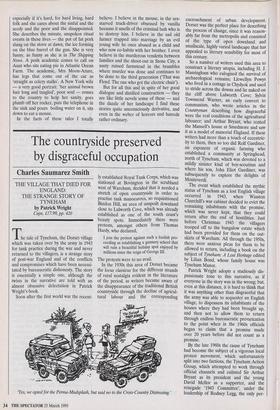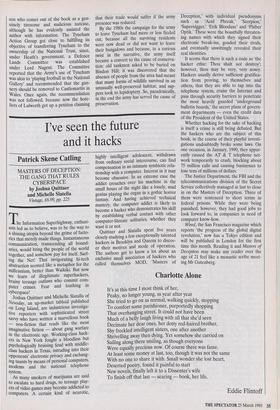The countryside preserved by disgraceful occupation
Charles Saumarez Smith
THE VILLAGE THAT DIED FOR ENGLAND: THE STRANGE STORY OF TYNEHAM by Patrick Wright Cape, £17.99, pp. 420 The tale of Tyneham, the Dorset village which was taken over by the army in 1943 for tank practice during the war and never returned to the villagers, is a strange story of post-war England and of the conflicts and compromises which have been necessi- tated by bureaucratic dishonesty. The story is essentially a simple one, although the twists in the narrative are told with an almost obsessive delectation in Patrick Wright's book. Soon after the first world war the recent- ly established Royal Tank Corps, which was stationed at Bovington in the scrubland west of Wareham, decided that it needed a stretch of open countryside in order to practise tank manoeuvres, so requisitioned Bindon Hill, an area of unspoilt downland close to Lulworth Cove, which was already established as one of the south coast's beauty spots. Immediately there were protests, amongst others from Thomas Hardy, who declared, I join the protest against such a foolish pro- ceeding as establishing a gunnery school that will ruin a beautiful holiday spot enjoyed by millions since the reign of George III.
The protests were to no avail. In the 1930s this area of Dorset became the locus classicus for the different strands of rural nostalgia evident in the literature of the period, as writers became aware of the disappearance of the traditional British countryside through the decline of agricul- tural labour and the corresponding `Yes, we opted for the Penna-Mudsplash, but said no to the Cross-Country Distressing.' encroachment of urban development.
Dorset was the perfect place for describing the process of change, since it was reason- ably far from the metropolis and consisted of the type of open downland and smallscale, highly varied landscape that has appealed to literary sensibility for most of this century.
So a number of writers used this area to construct a literary utopia, including H. J. Massingham who eulogised the survival of archaeological remains; Llewellyn Powys who lived in a cottage in Chydyok and used to stride across the downs and lie naked on the cliff above Lulworth Cove; Sylvia Townsend Warner, an early convert to communism, who wrote articles in the Countryman describing how disgraceful were the real conditions of the agricultural labourer; and Arthur Bryant, who rented the Mansell's house at Smedmore and saw it as a model of manorial England. If these writers had more than a touch of eccentric- ity to them, then so too did Rolf Gardiner, an exponent of organic farming who established a community at Springhead, north of Tyneham, which was devoted to a mildly sinister kind of boy-scoutism and where his son, John Eliot Gardiner, was subsequently to explore the delights of Monteverdi.
The event which established the mythic status of Tyneham as a lost English village occurred in 1943, when Winston Churchill's war cabinet decided to evict the remaining inhabitants with the promise, which was never kept, that they could return after the end of hostilities. Just before Christmas 1943 the villagers trooped off to the bungalow estate which had been provided for them on the out- skirts of Wareham. All through the 1950s, there were anxious pleas for them to be allowed to return, including a book on the subject of Tyneham: A Lost Heritage edited by Lilian Bond, whose family house was Tyneham Manor.
Patrick Wright adopts a studiously dis- passionate tone to this narrative, as if everyone in the story was in the wrong; but, even at this distance, it is hard to think that it was anything other than disgraceful that the army was able to sequester an English village, to dispossess its inhabitants of the houses where they had been brought up, and then not to allow them to return through endless bureaucratic prevarication to the point when in the 1960s officials began to claim that a promise made over 20 years before did not count as a promise.
By the late 1960s the cause of Tyneham had become the subject of a vigorous local protest movement, which unfortunately split into two factions, the Tyneham Action Group, which attempted to work through official channels and enlisted Sir Arthur Bryant as its president and the young David Mellor as a supporter, and the renegade '1943 Committee', under the leadership of Rodney Legg, the only per- son who comes out of the book as a gen- uinely tiresome and malicious nutcase, although be has evidently assisted the author with information. The Tyneham Action Group got close to fulfilling its objective of transferring Tyneham to the ownership of the National Trust, since, under Heath's government, a Defence Lands Committee was established under Lord Nugent. The Committee reported that the Army's use of Tyneham was akin to 'playing football in the National Gallery' and recommended that the gun- nery should be removed to Castlemartin in Wales. Once again, the recommendation was not followed, because now the hote- hers of Lulworth got up a petition claiming that their trade would suffer if the army presence was reduced. By the 1980s the campaign for the army to leave Tyneham had more or less fizzled out, because all the surviving residents were now dead or did not want to leave their bungalows and because, in a curious twist in the narrative, the army itself became a convert to the cause of conserva- tion: old tankmen asked to be buried on Bindon Hill; it was discovered that the absence of people from the area had meant that many forms of wildlife survived in an unusually well-preserved habitat; and sap- pers took to lepidoptery. So, paradoxically, in the end the army has served the cause of preservation.



























































 Previous page
Previous page